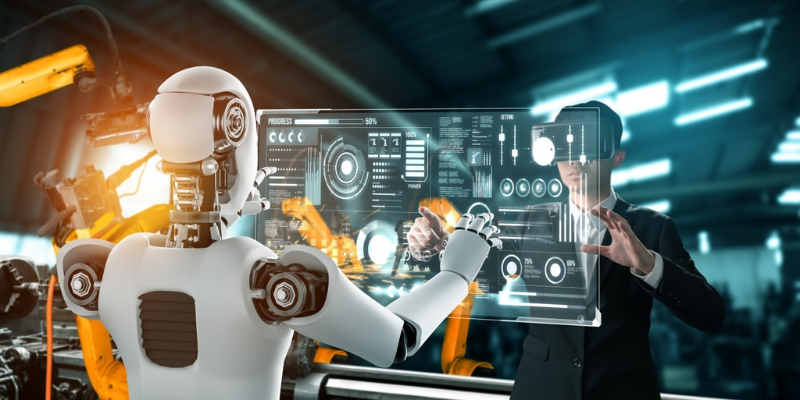Human-robot collaboration (HRC) is no longer a vision of science fiction—it’s a present-day reality reshaping industries around the globe. With advancements in artificial intelligence, machine learning, and robotics, the relationship between humans and machines is evolving from simple automation to dynamic partnerships. Robots can now do more than just carry out monotonous duties by themselves they now work side by side with human counterparts, enhancing productivity, safety, and innovation.
As we look to the future, understanding how this collaboration will evolve is critical. From manufacturing and healthcare to education and customer service, the synergy between humans and robots promises to redefine work environments, improve operational efficiency, and open up new career paths. The integration of key technologies and frameworks for developers also ensures that the design and deployment of collaborative robots (cobots) remain adaptable and secure. In order to obtain practical experience with robots and intelligent systems, professionals who want to succeed in this changing environment are increasingly turning to AI courses in Mumbai.
The Shift from Automation to Collaboration
Traditionally, automation replaced human tasks to increase efficiency and reduce costs. Robots worked in cages, isolated from humans due to safety concerns. However, the emergence of cobots—robots designed to interact safely with humans—has changed this paradigm. Cobots are equipped with sensors, AI-driven learning capabilities, and adaptive programming, enabling them to respond to human behavior in real time.
This shift marks a fundamental change in robotics. Rather than replacing workers, robots now assist them, taking over repetitive, dangerous, or physically demanding tasks. This allows human workers to focus on decision-making, creativity, and problem-solving—areas where human intelligence still outperforms AI.
Applications of Human-Robot Collaboration
1. Manufacturing
Manufacturing remains the most prominent sector for HRC. Cobots work alongside humans on assembly lines, handling tasks like welding, painting, and quality control. These robots are easy to program and reconfigure, making them ideal for small-batch or customized production runs.
Leading factories also use AI Courses in Gurgaon and other urban tech hubs to train engineers in robotic integration, ensuring seamless workflows between human workers and intelligent machines.
2. Healthcare
In hospitals and elder care facilities, robots assist with lifting patients, delivering supplies, and even performing surgeries with precision. Surgeons can work with robotic arms to enhance their dexterity during complex operations. AI also enables these machines to analyze patient data and suggest real-time adjustments, increasing safety and outcomes.
3. Logistics and Warehousing
Companies like Amazon and DHL deploy collaborative robots to sort, pack, and transport goods. These robots operate alongside human workers to speed up operations while minimizing physical strain.
4. Education and Training
Robots are being used to teach coding, provide personalized tutoring, and offer hands-on learning experiences in STEM education. In training simulations, particularly for industrial and defense sectors, robots provide realistic scenarios for users to practice complex procedures safely. Additionally, AI in Manufacturing Improves Efficiency, making these training simulations even more accurate and reflective of real-world applications.
Key Technologies Powering HRC
Several technologies underpin successful human-robot collaboration. These include:
- Artificial Intelligence: Enables decision-making, language processing, and adaptability in robotic behavior.
- Machine Learning: Helps robots learn from human feedback and improve over time.
- Computer Vision: Allows robots to interpret visual data, recognize objects, and interact with environments.
- Natural Language Processing: Enables conversational interaction between humans and robots.
- Edge Computing: Reduces latency by processing data near the source, essential for real-time decision-making in collaborative environments.
These technologies are also at the core of modern AI Course in Ahmedabad, where learners are trained to build secure, real-time applications that interact with IoT and robotic systems.
Benefits of Human-Robot Collaboration
Human-robot collaboration brings numerous benefits:
- Increased Efficiency: Robots handle repetitive tasks, allowing humans to focus on higher-value activities.
- Improved Safety: Cobots take over hazardous duties, reducing workplace injuries.
- Greater Flexibility: Cobots are easy to train and deploy, making them adaptable to changing tasks.
- Enhanced Innovation: Collaboration encourages new workflows and problem-solving approaches.
As these advantages become more pronounced, companies will increasingly invest in Mastering Full Stack Development and AI-based programs to create more robust HRC ecosystems.
Challenges and Ethical Considerations
Despite its promise, HRC also presents challenges:
- Safety: Ensuring safe interactions remains paramount, especially in high-speed or high-precision environments.
- Job Displacement Fears: While cobots aim to assist rather than replace, concerns about automation persist.
- Bias and Transparency: AI-driven robots must be trained on fair and representative data to avoid unintended discrimination.
- Privacy: Robots operating in healthcare or homes must protect sensitive user data.
It takes both technological innovation and moral insight to address these problems, supported by policies and continuous education—many of which are central to the curriculum of an AI Course in Kolkata.
The Road Ahead
The future of human-robot collaboration is incredibly promising. As technology advances, robots will become even more intuitive, empathetic, and seamlessly integrated into our daily lives. In the near future, we can expect:
- Collaborative robots capable of emotional intelligence
- AI-powered assistants that anticipate human needs
- Robots integrated into hybrid workspaces, both physical and virtual
- Increased use of Role of AI in Financial Forecasting and other data-driven applications alongside robotic tools
Human-robot collaboration is revolutionizing the way we work, live, and learn. Rather than replacing us, robots are becoming our partners—amplifying our strengths, compensating for our limitations, and creating fresh opportunities for development and creativity. As industries continue to embrace this shift, the demand for skills in AI, robotics, full stack development, and data science to enhance business intelligence will grow.

